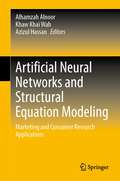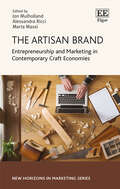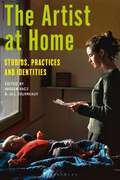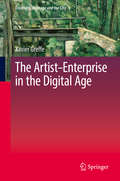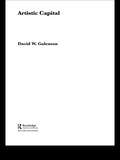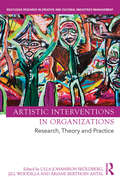- Table View
- List View
Artificial Neural Networks and Machine Learning – ICANN 2023: 32nd International Conference on Artificial Neural Networks, Heraklion, Crete, Greece, September 26–29, 2023, Proceedings, Part VI (Lecture Notes in Computer Science #14259)
by Lazaros Iliadis Antonios Papaleonidas Plamen Angelov Chrisina JayneThe 10-volume set LNCS 14254-14263 constitutes the proceedings of the 32nd International Conference on Artificial Neural Networks and Machine Learning, ICANN 2023, which took place in Heraklion, Crete, Greece, during September 26–29, 2023.The 426 full papers, 9 short papers and 9 abstract papers included in these proceedings were carefully reviewed and selected from 947 submissions. ICANN is a dual-track conference, featuring tracks in brain inspired computing on the one hand, and machine learning on the other, with strong cross-disciplinary interactions and applications.
Artificial Neural Networks and Machine Learning – ICANN 2023: 32nd International Conference on Artificial Neural Networks, Heraklion, Crete, Greece, September 26–29, 2023, Proceedings, Part II (Lecture Notes in Computer Science #14255)
by Lazaros Iliadis Antonios Papaleonidas Plamen Angelov Chrisina JayneThe 10-volume set LNCS 14254-14263 constitutes the proceedings of the 32nd International Conference on Artificial Neural Networks and Machine Learning, ICANN 2023, which took place in Heraklion, Crete, Greece, during September 26–29, 2023.The 426 full papers, 9 short papers and 9 abstract papers included in these proceedings were carefully reviewed and selected from 947 submissions. ICANN is a dual-track conference, featuring tracks in brain inspired computing on the one hand, and machine learning on the other, with strong cross-disciplinary interactions and applications.
Artificial Neural Networks and Machine Learning – ICANN 2023: 32nd International Conference on Artificial Neural Networks, Heraklion, Crete, Greece, September 26–29, 2023, Proceedings, Part V (Lecture Notes in Computer Science #14258)
by Lazaros Iliadis Antonios Papaleonidas Plamen Angelov Chrisina JayneThe 10-volume set LNCS 14254-14263 constitutes the proceedings of the 32nd International Conference on Artificial Neural Networks and Machine Learning, ICANN 2023, which took place in Heraklion, Crete, Greece, during September 26–29, 2023.The 426 full papers, 9 short papers and 9 abstract papers included in these proceedings were carefully reviewed and selected from 947 submissions. ICANN is a dual-track conference, featuring tracks in brain inspired computing on the one hand, and machine learning on the other, with strong cross-disciplinary interactions and applications.
Artificial Neural Networks and Machine Learning – ICANN 2023: 32nd International Conference on Artificial Neural Networks, Heraklion, Crete, Greece, September 26–29, 2023, Proceedings, Part III (Lecture Notes in Computer Science #14256)
by Lazaros Iliadis Antonios Papaleonidas Plamen Angelov Chrisina JayneThe 10-volume set LNCS 14254-14263 constitutes the proceedings of the 32nd International Conference on Artificial Neural Networks and Machine Learning, ICANN 2023, which took place in Heraklion, Crete, Greece, during September 26–29, 2023.The 426 full papers, 9 short papers and 9 abstract papers included in these proceedings were carefully reviewed and selected from 947 submissions. ICANN is a dual-track conference, featuring tracks in brain inspired computing on the one hand, and machine learning on the other, with strong cross-disciplinary interactions and applications.
Artificial Neural Networks and Machine Learning – ICANN 2023: 32nd International Conference on Artificial Neural Networks, Heraklion, Crete, Greece, September 26–29, 2023, Proceedings, Part X (Lecture Notes in Computer Science #14263)
by Lazaros Iliadis Antonios Papaleonidas Plamen Angelov Chrisina JayneThe 10-volume set LNCS 14254-14263 constitutes the proceedings of the 32nd International Conference on Artificial Neural Networks and Machine Learning, ICANN 2023, which took place in Heraklion, Crete, Greece, during September 26–29, 2023.The 426 full papers and 9 short papers included in these proceedings were carefully reviewed and selected from 947 submissions. ICANN is a dual-track conference, featuring tracks in brain inspired computing on the one hand, and machine learning on the other, with strong cross-disciplinary interactions and applications.
Artificial Neural Networks and Machine Learning – ICANN 2023: 32nd International Conference on Artificial Neural Networks, Heraklion, Crete, Greece, September 26–29, 2023, Proceedings, Part IV (Lecture Notes in Computer Science #14257)
by Lazaros Iliadis Antonios Papaleonidas Plamen Angelov Chrisina JayneThe 10-volume set LNCS 14254-14263 constitutes the proceedings of the 32nd International Conference on Artificial Neural Networks and Machine Learning, ICANN 2023, which took place in Heraklion, Crete, Greece, during September 26–29, 2023.The 426 full papers, 9 short papers and 9 abstract papers included in these proceedings were carefully reviewed and selected from 947 submissions. ICANN is a dual-track conference, featuring tracks in brain inspired computing on the one hand, and machine learning on the other, with strong cross-disciplinary interactions and applications.
Artificial Neural Networks and Machine Learning – ICANN 2023: 32nd International Conference on Artificial Neural Networks, Heraklion, Crete, Greece, September 26–29, 2023, Proceedings, Part IX (Lecture Notes in Computer Science #14262)
by Lazaros Iliadis Antonios Papaleonidas Plamen Angelov Chrisina JayneThe 10-volume set LNCS 14254-14263 constitutes the proceedings of the 32nd International Conference on Artificial Neural Networks and Machine Learning, ICANN 2023, which took place in Heraklion, Crete, Greece, during September 26–29, 2023.The 426 full papers and 9 short papers included in these proceedings were carefully reviewed and selected from 947 submissions. ICANN is a dual-track conference, featuring tracks in brain inspired computing on the one hand, and machine learning on the other, with strong cross-disciplinary interactions and applications.
Artificial Neural Networks and Machine Learning – ICANN 2023: 32nd International Conference on Artificial Neural Networks, Heraklion, Crete, Greece, September 26–29, 2023, Proceedings, Part I (Lecture Notes in Computer Science #14254)
by Lazaros Iliadis Antonios Papaleonidas Plamen Angelov Chrisina JayneThe 10-volume set LNCS 14254-14263 constitutes the proceedings of the 32nd International Conference on Artificial Neural Networks and Machine Learning, ICANN 2023, which took place in Heraklion, Crete, Greece, during September 26–29, 2023.The 426 full papers, 9 short papers and 9 abstract papers included in these proceedings were carefully reviewed and selected from 947 submissions. ICANN is a dual-track conference, featuring tracks in brain inspired computing on the one hand, and machine learning on the other, with strong cross-disciplinary interactions and applications.
Artificial Neural Networks and Machine Learning – ICANN 2023: 32nd International Conference on Artificial Neural Networks, Heraklion, Crete, Greece, September 26–29, 2023, Proceedings, Part VII (Lecture Notes in Computer Science #14260)
by Lazaros Iliadis Antonios Papaleonidas Plamen Angelov Chrisina JayneThe 10-volume set LNCS 14254-14263 constitutes the proceedings of the 32nd International Conference on Artificial Neural Networks and Machine Learning, ICANN 2023, which took place in Heraklion, Crete, Greece, during September 26–29, 2023.The 426 full papers, 9 short papers and 9 abstract papers included in these proceedings were carefully reviewed and selected from 947 submissions. ICANN is a dual-track conference, featuring tracks in brain inspired computing on the one hand, and machine learning on the other, with strong cross-disciplinary interactions and applications.
Artificial Neural Networks and Machine Learning – ICANN 2023: 32nd International Conference on Artificial Neural Networks, Heraklion, Crete, Greece, September 26–29, 2023, Proceedings, Part VIII (Lecture Notes in Computer Science #14261)
by Lazaros Iliadis Antonios Papaleonidas Plamen Angelov Chrisina JayneThe 10-volume set LNCS 14254-14263 constitutes the proceedings of the 32nd International Conference on Artificial Neural Networks and Machine Learning, ICANN 2023, which took place in Heraklion, Crete, Greece, during September 26–29, 2023.The 426 full papers, 9 short papers and 9 abstract papers included in these proceedings were carefully reviewed and selected from 947 submissions. ICANN is a dual-track conference, featuring tracks in brain inspired computing on the one hand, and machine learning on the other, with strong cross-disciplinary interactions and applications.
Artificial Neural Networks and Structural Equation Modeling: Marketing and Consumer Research Applications
by Alhamzah Alnoor Khaw Khai Wah Azizul HassanThis book goes into a detailed investigation of adapting artificial neural network (ANN) and structural equation modeling (SEM) techniques in marketing and consumer research. The aim of using a dual-stage SEM and ANN approach is to obtain linear and non-compensated relationships because the ANN method captures non-compensated relationships based on the black box technology of artificial intelligence. Hence, the ANN approach validates the results of the SEM method. In addition, such the novel emerging approach increases the validity of the prediction by determining the importance of the variables. Consequently, the number of studies using SEM-ANN has increased, but the different types of study cases that show customization of different processes in ANNs method combination with SEM are still unknown, and this aspect will be affecting to the generation results. Thus, there is a need for further investigation in marketing and consumer research. This book bridges the significant gap in this research area. The adoption of SEM and ANN techniques in social commerce and consumer research is massive all over the world. Such an expansion has generated more need to learn how to capture linear and non-compensatory relationships in such area. This book would be a valuable reading companion mainly for business and management students in higher academic organizations, professionals, policy-makers, and planners in the field of marketing. This book would also be appreciated by researchers who are keenly interested in social commerce and consumer research.
Artikulationen Sexueller Gewalt: Biographien, Diskurse und der Übergang zum Sprechen (Sexuelle Gewalt in Kindheit und Jugend: Forschung als Beitrag zur Aufarbeitung)
by Andrea PohlingNicht erst seit dem Jahr 2010 wird über das Thema der sexuellen Gewalt geforscht und gesprochen. Aber wie sprechen betroffene Menschen in biographischen Interviews über ihre Erfahrungen sexueller Gewalt in Kindheit und Jugend? Und wie gehen sie im Verlauf ihres Lebens dazu über, über diese Erfahrungen zu sprechen oder wenden sich davon ab? Die Studie leistet einen Beitrag zu einer erziehungswissenschaftlich ausgerichteten Gewaltforschung in Anlehnung an das Konzept der Artikulation. Sie zeigt auf, wie der Übergang zum Sprechen über sexuelle Gewalt in Kindheit und Jugend in diskursive und gesellschaftliche Verhältnisse einerseits sowie in biographische Erfahrungen und Bearbeitungsstrategien andererseits eingebunden ist. Vor diesem Hintergrund wird die Vielfältigkeit „des“ Sprechens über Sexuelle Gewalterfahrungen beleuchtet und verschiedene Modi der Artikulation Sexueller Gewalt vorgestellt. Auf der Grundlage von drei Falldarstellungen wird der Übergang zum Sprechen als mehrdimensionaler, nicht-linearer und relationalerProzess definiert.Die AutorinAndrea Pohling ist wissenschaftliche Mitarbeiterin an der Goethe-Universität Frankfurt am Main am Institut für Sozialpädagogik und Erwachsenenbildung. Ihre Arbeitsschwerpunkte und Forschungsinteressen sind Kindheits- und Jugendforschung, Forschung im Kontext der Themen Sexualität, (sexuelle) Gewalt und Diskurse, Methoden qualitativer Sozialforschung sowie forschungsethische Fragen und Spannungsfelder.
The Artisan Brand: Entrepreneurship and Marketing in Contemporary Craft Economies (New Horizons in Marketing series)
Investigating the changing forms, dynamics and trajectories of the artisan and craft sector, this timely book considers the opportunities, challenges, and uncertainties associated with artisanal businesses in new economic times.Exploring how artisanal and craft products remain vibrant embodiments of tradition, heritage, authenticity and creativity, the book explores how these qualities are being harnessed and transformed to enable artisanal businesses to exploit the opportunities presented by technological innovation and evolving consumption patterns for their future viability and vitality. Revolutionary advancement in digital technologies offer ‘game-changing’ possibilities for artisanship and craft, across a spectrum ranging from production practices to e-commerce. But such technological advancements also present challenges to how artisanship sustains its important ‘traditional’ associations, and how it builds on its relationship with the ethical, the sustainable and the local. Featuring an international range of case studies, chapters exemplify how artisanal organisations can revitalise their business models, using innovative branding and marketing strategies, and entrepreneurship, to utilise the best of both the past and the future.This cutting-edge book will prove invaluable to students and scholars of marketing, business studies and sociology who are interested in contemporary innovation in artisanship and craft. With practical advice from industry experts, it also serves as a useful resource for practitioners and stakeholders within the artisanal and craft sector who might be concerned with the impact of digitalisation on the field.
The Artist at Home: Studios, Practices and Identities
by Imogen Racz and Jill JourneauxArtists have worked from home for many reasons, including care duties, financial or political constraints, or availability and proximity to others.From the 'home studios' of Charles and Ray Eames, to the different photographic representations of Robert Rauschenberg's studio, this book explores the home as a distinct site of artistic practice, and the traditions and developments of the home studio as concept and space throughout the 20th and into the 21st century.Using examples from across Europe and the Anglophone world between the mid-20th century and the present, each chapter considers the different circumstances for working at home, the impact on the creative lives of the artists, their identities as artists and on the work itself, and how, sometimes, these were projected and promoted through photographs and the media. Key themes include the gendered and performative aspects of women practising 'at home', collaborative studio communities of the 1970s – 90s including the appropriation of abandoned spaces in East London, and the effects of Covid on artistic practices and family life within the spaces of 'home'. The book comprises full-length chapters by artists, architects, art and design historians, each of whom bring different perspectives to the issues, interwoven with short interviews with artists to enrich and broaden the debates. At a time when individual relationships to home environments have been radically altered, The Artist at Home considers why some artists in previous decades either needed to or chose to work from home, producing work of vitality and integrity. Tracing this long tradition into the present, the book will provide a deeper understanding of how the home studio has affected the practices and identity of artists working in different countries, and in different circumstances, from the mid-20th century to the present.
The Artist at Home: Studios, Practices and Identities
Artists have worked from home for many reasons, including care duties, financial or political constraints, or availability and proximity to others.From the 'home studios' of Charles and Ray Eames, to the different photographic representations of Robert Rauschenberg's studio, this book explores the home as a distinct site of artistic practice, and the traditions and developments of the home studio as concept and space throughout the 20th and into the 21st century.Using examples from across Europe and the Anglophone world between the mid-20th century and the present, each chapter considers the different circumstances for working at home, the impact on the creative lives of the artists, their identities as artists and on the work itself, and how, sometimes, these were projected and promoted through photographs and the media. Key themes include the gendered and performative aspects of women practising 'at home', collaborative studio communities of the 1970s – 90s including the appropriation of abandoned spaces in East London, and the effects of Covid on artistic practices and family life within the spaces of 'home'. The book comprises full-length chapters by artists, architects, art and design historians, each of whom bring different perspectives to the issues, interwoven with short interviews with artists to enrich and broaden the debates. At a time when individual relationships to home environments have been radically altered, The Artist at Home considers why some artists in previous decades either needed to or chose to work from home, producing work of vitality and integrity. Tracing this long tradition into the present, the book will provide a deeper understanding of how the home studio has affected the practices and identity of artists working in different countries, and in different circumstances, from the mid-20th century to the present.
The Artist–Enterprise in the Digital Age (Creativity, Heritage and the City #1)
by Xavier GreffeThis book is a monograph of cultural economics of a new concept, artist–enterprises. It explores various dimensions that artists embody, i.e., aesthetic, critical, messianic, and economic ones, and screens the multiple challenges faced by the artist–enterprises in terms of pricing, funding, and networking in the Digital Age. It shows how these artist–enterprises are at the core of the contemporary creative industries.Even when they are on their own, artists have to demonstrate or manage a variety of skills, sign contracts both in the early and later stages of their activities, and also maintain relationships and networks that enable them to attain their artistic and economic goals. They are no longer simply entrepreneurs managing their own skills but are the enterprises themselves. The artist–enterprises thus find themselves at the confluence of two dynamics of production—artistic and economic: artistic because they invent new expressions and meanings; and economic because these expressions must be supported by monetary values on the market. The artistic dynamic is part of a long process of artistic enhancement and only an artist can say whether it has reached the point of presentation or equilibrium. The economic dynamic is dependent on the constant endorsement of artists' works by the market to ensure their survival as artist–enterprises. The tension created by this disparity is further aggravated by another tension: the need to overcome a number of risks so that artist–enterprises can progress.This book will be of special interest to artists, managers, students, professionals, and researchers in the fields of the arts, creativity, economics, and development.The author is Emeritus Professor at the University Paris I Panthéon-Sorbonne.
Artistic Capital
by David GalensonAt what stage of their careers do great artists produce their most important work? In a series of studies that bring new insights and new dimensions to the study of artistic creativity, Galenson’s new book examines the careers of more than one hundred modern painters, poets and novelists to reveal a powerful relationship between age and artistic creativity. Analyzing the careers of major literary and artistic figures, such as Cézanne, van Gogh, Dickens, Hemingway and Plath, Galenson highlights the different methods by which artists have made innovations. Pointing to a new and richer history of the modern arts, this book is of interest, not only to humanists and social scientists, but to anyone interested in the nature of human creativity in general.
Artistic Capital
by David GalensonAt what stage of their careers do great artists produce their most important work? In a series of studies that bring new insights and new dimensions to the study of artistic creativity, Galenson’s new book examines the careers of more than one hundred modern painters, poets and novelists to reveal a powerful relationship between age and artistic creativity. Analyzing the careers of major literary and artistic figures, such as Cézanne, van Gogh, Dickens, Hemingway and Plath, Galenson highlights the different methods by which artists have made innovations. Pointing to a new and richer history of the modern arts, this book is of interest, not only to humanists and social scientists, but to anyone interested in the nature of human creativity in general.
Artistic Enclaves in the Post-Industrial City: A Case Study of Lawrenceville Pittsburgh (SpringerBriefs in Sociology)
by Geoffrey MossThis SpringerBriefs presents a case study and theoretical analysis of an artistic enclave that emerged within Lawrenceville Pittsburgh. It briefly describes the history of greater Pittsburgh, and Lawrenceville’s transition from thriving blue-collar community to depopulated low-income neighborhood to gentrifying site of artistic and creative culture. It draws on multiple methods (e.g., interviews, observations, and survey data) to discuss the advantages and disadvantages associated with being a Pittsburgh artist, and offer a detailed description of the origins and ongoing development of Lawrenceville’s artistic enclave. It discusses this enclave in the context of sociological, historical, and interdisciplinary work on urban artistic communities (i.e., bohemian and quasi-bohemian communities), and situates it within the larger urban artistic tradition, and within its contemporary urban context. It maintains that this enclave constitutes a successful (i.e., sustainable) example of an artistic creative class enclave, a heuristic concept that clarifies and amends Richard Florida’s brief commentary on contemporary urban artistic life. It concludes by offering policy suggestions for those who wish to promote such enclaves, and a preliminary critical appraisal of their potential impact on society.
Artistic Interventions in Organizations: Research, Theory and Practice (Routledge Research in the Creative and Cultural Industries)
by Ariane Berthoin Antal Ulla Johansson Sköldberg Jill WoodillaArtistic intervention, where the world of the arts is brought into organizations, has increasingly become a research field in itself with strong links to both creativity and innovation. Opportunities for the arts to interact with public and private organizations occur worldwide, but during the last decade artistic interventions have received growing attention in both practice and research. This book is the first comprehensive attempt to map the development of the field and provides an international overview of the area of artistic interventions and their impact on organizations from different perspectives, ranging from strategic management to organizational development, innovation and organizational learning. Featuring chapters from prominent and emerging scholars, including Nancy J. Adler, Barbara Czarniawska, Lotte Darsø and Alexander Styhre, it places artistic interventions within an international context. The book also offers readers the opportunity to learn from experiences in a varied range of organisations, including newspapers, manufacturing, government, schools, and covers many art-forms, such as music, contemporary dance, painting, photography, and theatre. Using extensive empirical examples, this book is vital reading for researchers and scholars of creativity and cultural industries, as well as innovation, creative entrepreneurship, organizational studies and management.
Artistic Interventions in Organizations: Research, Theory and Practice (Routledge Research in the Creative and Cultural Industries)
by Ariane Berthoin Antal Ulla Johansson Sköldberg Jill WoodillaArtistic intervention, where the world of the arts is brought into organizations, has increasingly become a research field in itself with strong links to both creativity and innovation. Opportunities for the arts to interact with public and private organizations occur worldwide, but during the last decade artistic interventions have received growing attention in both practice and research. This book is the first comprehensive attempt to map the development of the field and provides an international overview of the area of artistic interventions and their impact on organizations from different perspectives, ranging from strategic management to organizational development, innovation and organizational learning. Featuring chapters from prominent and emerging scholars, including Nancy J. Adler, Barbara Czarniawska, Lotte Darsø and Alexander Styhre, it places artistic interventions within an international context. The book also offers readers the opportunity to learn from experiences in a varied range of organisations, including newspapers, manufacturing, government, schools, and covers many art-forms, such as music, contemporary dance, painting, photography, and theatre. Using extensive empirical examples, this book is vital reading for researchers and scholars of creativity and cultural industries, as well as innovation, creative entrepreneurship, organizational studies and management.
Artistic Lives: A Study of Creativity in Two European Cities
by Kirsten ForkertArtistic Lives examines cultural production as a non-standard, self-directed, and frequently unpaid activity, which is susceptible to developments that affect the availability of unstructured time. It engages with discourses which have historically had little to do with the arts, including urban sociology and social policy research, to explore the social conditions and identities of ordinary artists, revealing the importance of the cost of living or access to housing, benefits or employment in determining who is able to become an artist or sustain an artistic career. The book thus challenges recent policy discourses that celebrate the ability of cultural producers to create something from nothing, and, more generally, the myth of creativity as an individual phenomenon, divorced from social context. Presenting rich interview material with artists and arts professionals in London and Berlin, together with ethnographic descriptions, Artistic Lives engages with debates surrounding Post-Fordism, gentrification and the nature of authorship, to raise challenging questions about the function of culture and the role of cultural producers within contemporary capitalism. An empirically grounded exploration of the identity of the modern artist and his or her ability to make a living in neoliberal societies, Artistic Lives will be of interest to students and scholars researching urban studies, the sociology of art and creative cultures, social stratification and social policy.
Artistic Lives: A Study of Creativity in Two European Cities
by Kirsten ForkertArtistic Lives examines cultural production as a non-standard, self-directed, and frequently unpaid activity, which is susceptible to developments that affect the availability of unstructured time. It engages with discourses which have historically had little to do with the arts, including urban sociology and social policy research, to explore the social conditions and identities of ordinary artists, revealing the importance of the cost of living or access to housing, benefits or employment in determining who is able to become an artist or sustain an artistic career. The book thus challenges recent policy discourses that celebrate the ability of cultural producers to create something from nothing, and, more generally, the myth of creativity as an individual phenomenon, divorced from social context. Presenting rich interview material with artists and arts professionals in London and Berlin, together with ethnographic descriptions, Artistic Lives engages with debates surrounding Post-Fordism, gentrification and the nature of authorship, to raise challenging questions about the function of culture and the role of cultural producers within contemporary capitalism. An empirically grounded exploration of the identity of the modern artist and his or her ability to make a living in neoliberal societies, Artistic Lives will be of interest to students and scholars researching urban studies, the sociology of art and creative cultures, social stratification and social policy.
Artistic Practices: Social Interactions and Cultural Dynamics (Studies in European Sociology)
by Tasos ZembylasArt matters. It affects us in our daily lives and is full of meanings that are valuable to all of us. As a catalyst for social interactions, art may either cause public conflict and create dissensions or facilitate mutual understanding and strengthen collective bonds. All of this is grounded in practices that develop and change along social interaction, cultural dynamics, as well as technological and economic lines. So how is art formed and produced? What are the relevant constraints and challenges that artists experience in the creative process? And what constitutes artistic agency? This collection of contributions from international, interdisciplinary experts explores particular case studies to deeply analyse artistic practices. Comprising eleven chapters relating to different art forms, each chapter offers an original perspective conveying a comprehensive understanding of artistic practices as arrays of specific activities in contemporary art worlds. This book will be important for both researchers and practitioners in the field. It will help artists to deepen their analytical abilities, enabling them to further their own creative practice. It will allow students and researchers to gain insights into processes of artistic creation and thus into the reproduction of art, as well as innovation in the arts.
Artistic Practices: Social Interactions and Cultural Dynamics (Studies in European Sociology)
by Tasos ZembylasArt matters. It affects us in our daily lives and is full of meanings that are valuable to all of us. As a catalyst for social interactions, art may either cause public conflict and create dissensions or facilitate mutual understanding and strengthen collective bonds. All of this is grounded in practices that develop and change along social interaction, cultural dynamics, as well as technological and economic lines. So how is art formed and produced? What are the relevant constraints and challenges that artists experience in the creative process? And what constitutes artistic agency? This collection of contributions from international, interdisciplinary experts explores particular case studies to deeply analyse artistic practices. Comprising eleven chapters relating to different art forms, each chapter offers an original perspective conveying a comprehensive understanding of artistic practices as arrays of specific activities in contemporary art worlds. This book will be important for both researchers and practitioners in the field. It will help artists to deepen their analytical abilities, enabling them to further their own creative practice. It will allow students and researchers to gain insights into processes of artistic creation and thus into the reproduction of art, as well as innovation in the arts.










